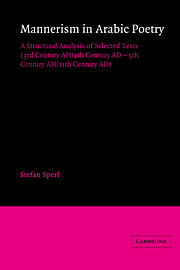 Mannerism in Arabic Poetry
Mannerism in Arabic Poetry Summary
Stimulated by the debate on mannerism in literature which followed the appearance of E. R. Curtius's celebrated work European Literature and Latin Middle Ages (1953), this book attempts to identify elements of mannerism and classicism in medieval Arabic poetry.
Mannerism in Arabic has usually been linked with the appearance of an ornate rhetorical style caled badī which became characteristic of poetry and prose from the fifth century AH/ninth century AD onwards. This study, however, is not so much concerned with the discussion of rhetorical devices as manifest in selected passages and individual lines of poetry; rather, it seeks to attain its objective through a structuralist analysis of whole poems. This makes it necessary to address the much-debated issue of the unity of the individual poem in Arabic.
The inquiry, therefore, begins with the formulation of a hypothesis on the structural coherence of a cardinal form of poetic expression – the polythematic, panegyric ode or qasīda (see Glossary). In chapters two and three this hypothesis serves as a basis for structuralist analyses of poems by Buhturī (d. about 284 AH/897 AD) and Mihyār al-Daylamī (d. 428 AH/1036 AD). Chapters four and five turn to ascetic poetry. Selected works from the Zuhdiyyātof Abū l ‘Atāhiya (d. 213 AH/828 AD) and the Luzūmiyyāt of Ma‘arrī (d. 449 AH/1058 AD) are examined in the light of the same hypothesis. The texts of all works analysed appear with translations and brief commentaries as an appendix to this book.
- Type
- Chapter
- Information
- Mannerism in Arabic PoetryA Structural Analysis of Selected Texts (3rd Century AH/9th Century AD – 5th Century AH/11th Century AD), pp. 1 - 8Publisher: Cambridge University PressPrint publication year: 1989
